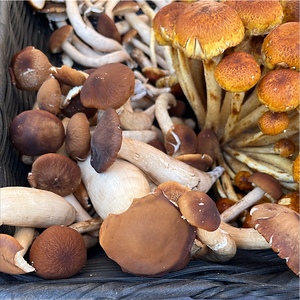


Yanagi Matsutake Mushrooms
Estimated Inventory, lb : 0
Description/Taste
Yanagi Matsutake mushrooms are small to medium in size with convex to flattened caps connecting to thin stems. The soft caps average 3-10 centimeters in diameter and range in color from dark brown to light brown-grey growing darker towards the center. Underneath the cap, there are small, grey-brown gills containing dark spores and the gills connect to the firm and fibrous cream-colored stem. Yanagi Matsutake mushrooms have a faint floral aroma and are meaty and crunchy with a nutty, woody and earthy flavor.
Seasons/Availability
Wild Yanagi Matsutake mushrooms are available in the summer through fall, while cultivated mushrooms are available year-round.
Current Facts
Yanagi Matsutake mushrooms, botanically classified as Agrocybe aegerita, are wild, edible mushrooms that belong to the Strophariaceae family. Also known as the Black Poplar mushroom, Velvet Pioppini, Tea Tree mushroom, Swordbelt Agrocybe, Zhuzhuang-Tiantougu, and Pholiote du Peuplier, Yanagi Matsutake mushrooms form large clusters on deciduous wood debris of willow trees and their aroma is slightly similar to the famous matsutake mushroom, which led them to receive their Japanese namesake meaning matsutake mushroom from the willow tree. They are also found on logs and in holes around poplar trees, chestnut trees, tea-oil trees, cottonwoods, box elders, trident maple trees, and elm trees. Yanagi Matsutake mushrooms are highly favored in Asia for their nutty flavor and are commonly added to stir-fries, hot pots, and soups.
Nutritional Value
Yanagi Matsutake mushrooms are rich in copper and vitamin B5, and also contain potassium, biotin, folate, selenium, and vitamins B2 and B3. Additionally, they have anti-fungal and antibiotic properties.
Applications
Yanagi Matsutake mushrooms are best suited for cooked applications such as boiling, steaming, or sautéing. The caps of the mushroom are soft, but the stems are tough and may require boiling prior to stir-frying or sautéing to soften the texture. When cooked, they can be added to salads, miso soups, nimono, ohitashi, marinated meat dishes, stir-fries, tempura, risotto, hot pot, gravies, and white sauces. They can also be cooked in quiches, omelets, casseroles, stews, and soups. Yanagi Matsutake mushrooms pair well with pancetta, poultry, pork, steak, fish, feta cheese, red chilies, garlic, onions, scallions, ginger, cilantro, celery, carrots, red bell pepper, brown sugar, soy sauce, oyster sauce, vinaigrettes, and white sesame seeds. They will keep up to four days when stored in a paper bag in the refrigerator.
Ethnic/Cultural Info
In China, Yanagi Matsutake mushrooms are used in traditional medicine to help reduce symptoms of nausea, fevers, and headache. They are also used for their anti-inflammatory and anti-fungal properties to help keep the kidneys healthy and to protect the overall health of the digestive system.
Geography/History
Yanagi Matsutake mushrooms are native to Japan, growing wild since ancient times, and are harvested predominately in Aoki which is in the Nagano prefecture. They have also been found growing in the southeastern United States, specifically, Mississippi, Louisiana, and Georgia as well as in southern Europe, Asia, and Australia. Yanagi Matsutake mushrooms are sold in farmers markets and specialty grocers.
Recipe Ideas
Recipes that include Yanagi Matsutake Mushrooms. One
Podcast








